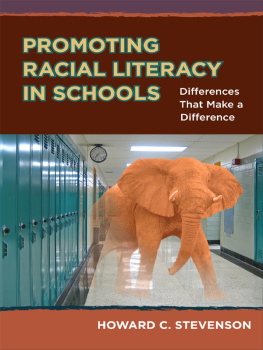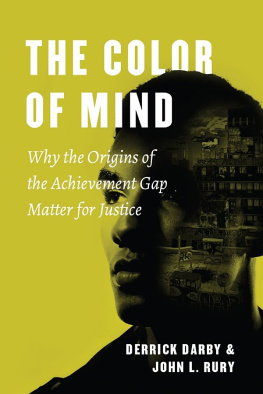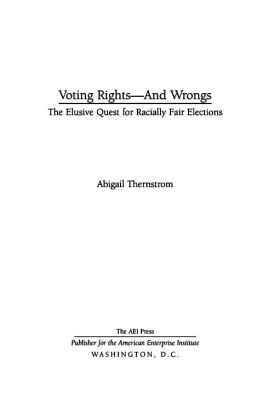
ALSO BY ABIGAIL THERNSTROM AND STEPHAN THERNSTROM
America in Black and White: One Nation, Indivisible
Beyond the Color Line: New Perspectives on Race and Ethnicity
in America(editors)
BOOKS BY ABIGAIL THERNSTROM
Whose Votes Count?: Affirmative Action and Minority Voting Rights
A Democracy Reader: Classic and Modern Speeches, Essays, Poems,
Declarations and Documents on Freedom and Human Rights Worldwide
(with Diane Ravitch)
School Choice in Massachusetts
BOOKS BY STEPHAN THERNSTROM
Poverty and Progress: Social Mobility in a 19th-Century City
Nineteenth-Century Cities: Essays in the New Urban History
(edited with Richard Sennett)
Poverty, Politics, and Planning in the New Boston: The Origins of ABCD
The Other Bostonians:
Poverty and Progress in the American Metropolis 1880-1970
Harvard Encyclopedia of American Ethnic Groups (editor)
A History of the American People
Our Changing Population (with Richard Gill and Nathan Glazer)
No Excuses
Closing the Racial Gap
in Learning
Abigail Themstrom
and Stephan Themstrom


SIMON & SCHUSTER
Rockefeller Center
1230 Avenue of the Americas
New York, NY 10020
www.SimonandSchuster.com
Copyright 2003 by Abigail Thernstrom and Stephan Thernstrom
All rights reserved,
including the right of reproduction
in whole or in part in any form.
SIMON & SCHUSTER AND COLOPHON ARE REGISTERED TRADEMARKS
of Simon & Schuster, Inc.
Designed by Karolina Hanis
Manufactured in the United States of America
10 9 8 7 6 5
Library of Congress Cataloging-in-Publication Data
Thernstrom, Abigail M., 1936-
No excuses : closing the racial gap in learning /
Abigail Thernstrom and Stephan Thernstom.
p. cm.
Includes bibliographical references and index.
1. Minority studentsUnited States. 2. Academic
achievementUnited States. 3. Educational equalization
United States. 4. EducationSocial aspectsUnited States.
I. Thernstrom, Stephan. II. Title.
LC3731.T45S 2003
371.829V0973dc21 20030S4439
ISBN 0-7432-0446-8
eISBN-13: 978-1-4391-2704-9
For information regarding special discounts for bulk purchases,
please contact Simon & Schuster Special Sales at
1-800-456-6798 orbusiness@simonandschuster.com
Acknowledgments
We dont know any authors who write books alone. In our case, we are deeply indebted to the institutions and foundations that supported us, to a great collection of research assistants, to a handful of friends and colleagues who read the final manuscript, and to educators and educational scholars too numerous to name who were willing to talk and keep talking as we struggled with ideas.
Abigail Thernstrom has been a senior fellow at the Manhattan Institute for Policy Research since 1993, and MPs support has been indispensable in writing this book. Lawrence Mone, Manhattan Institutes president, has turned a small organization into a large and thriving home for scholars working on public policy, and we are enormously grateful for his unwavering commitment to this project. We thank, as well, the generosity of the John M. Olin Foundation and the Earhart Foundation, both of which contributed substantially to the funding of the book.
Since 1999, Stephan Thernstrom has also been a senior fellow at the Manhattan Institute, and that association has meant support for both research assistants and research-related travel. He took sabbatical leave from Harvard in 1998-1999, and Harvard University and the John M. Olin foundation made that break from teaching possible.
Cornelia Davidson was a gift to us from the Earhart Foundation. Twice a week for three and a half years, she kept the almost overwhelming flow of information on education in order, chased down stories and facts on the Web and elsewhere, and served as a wonderful sounding board and critic, prompting us on many occasions to revise arguments. Kevin Amer, Thomas Koelbl, Michael Shumsky, and David Weinfeldall of them either undergraduates or taking time out between college and law schoolwere splendid research assistants at one time or another. They, too, not only worked on substantive issues but gave us terrific feedback. Michael Dotsikas of the Manhattan Institute provided invaluable help with the preparation of the graphs.
At the point at which we had a complete draft of the manuscript, Norman Atkins, Douglas Besharov, Rafe Esquith, Michael Feinberg, Tom Fortmann, Bill Guenther, David Levin, Brett Peiser, James Peyser, Diane Ravitch, Ricky Silberman, and Grant Ujifusa read some or all of it carefully. For his detailed critique of many substantive points, we are particularly indebted to Bill Guenther, who as president of Mass Insight has been deeply involved in education in Massachusetts for many years. Our son, Sam, read the manuscript once for substance, prompting important revisions, and then, in a break between jobs, provided extraordinary line editing. Our daughter, Melanie, doesnt edit our books, but she enriches our life in a multitude of other ways.
Finally, Glen Hartley and Lynn Chu, Writers Representatives, have been our long-standing, wonderful literary agents, and Bob Bender is the perfect Simon & Schuster editor. We thank all three profusely.
Abigail Thernstrom
Stephan Thernstrom
Lexington, Massachusetts
To Thomas Sowell
for his pioneering scholarship and unflagging courage
Contents
List of Figures
One: Left Behind
. The Four-Year Gap: How Black and Hispanic High School Seniors Perform Compared to Whites and Asians in the 8th Grade
. Percentage of 12th-Graders Scoring Below Basic on the Most Recent NAEP Assessments
. Percentage of 12th-Graders Rated as Proficient or Advanced on the Most Recent NAEP Assessment
. Trends in the Reading Gap: Percentile Rank of the Average Black and Hispanic 17-Year-Old, 1975-1999
. Trends in the Mathematics Gap: Percentile Rank of the Average Black and Hispanic 17-Year-Old, 1978-1999
. Trends in the Science Gap: Percentile Rank of the Average Black and Hispanic 17-Year-Old, 1977-1999
Two: Tests Matter
. Education Attained by the 1988 8th-Graders in the National Education Longitudinal Study Sample, 2000
. Adult Prose Literacy by Years of Education Completed, 1992
. Adult Quantitative Literacy by Years of Education Completed, 1992
. Median Annual Income by Years of School Completed, 1999
Five: Asians
. Percentage of Members of Various Racial Groups Who Qualified for Admission to the University of California, 1999 High School Graduates
. Asian Americans as Percentage of all 17-Year-Olds, of All Students Taking the SAT, and of Those Scoring 750 or Better on the SAT I and Various SAT II Tests, 1999
Next page






